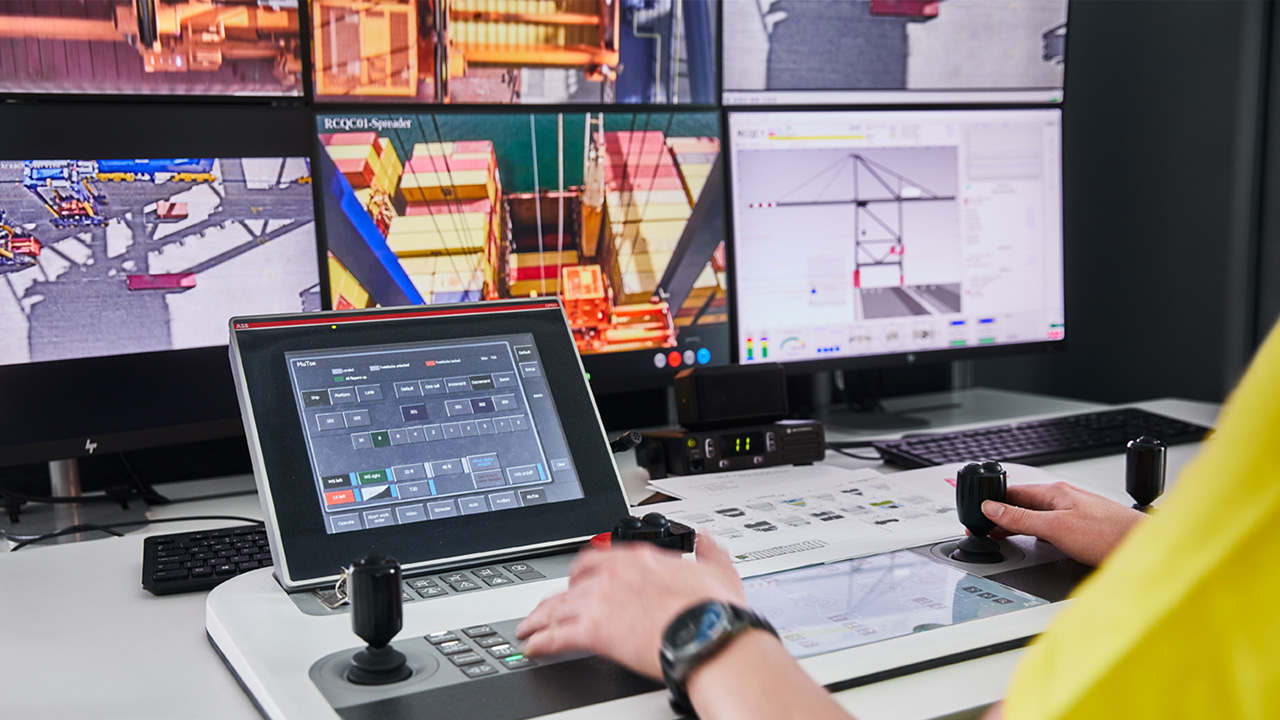In the world of maritime ports, where every second a vessel spends at berth translates to cost, and every container moved is a link in the global supply chain, optimizing STS crane productivity is no longer an option, but an inevitability. This trend is manifested through two main approaches to container handling with STS cranes: Semi-automation and Full Automation.
Semi-automation
This is the most common and practical step for most existing ports looking to enhance efficiency without a complete overhaul of their operations.
1. The Essence of STS Crane Semi-Automation:
Semi-automation does not mean eliminating the operator. On the contrary, it equips the operator with new capabilities by automating repetitive and high-precision tasks, while humans still perform decisive actions or handle specific, emergent situations. The operator remains in the cabin, but their job becomes significantly easier, faster, and safer.
2. Core Technologies of Semi-Automated STS Cranes:
-
Active Anti-Sway System: This is the most fundamental feature. Intelligent algorithms control the trolley and hoist motors to dampen the spreader’s sway almost instantaneously, making control much easier.
-
Benefits: Significantly reduces the time spent waiting for the container to stabilize, allowing the operator to land the container accurately on the first attempt. Cycle time productivity can increase by 10-15%. In the long run, it also reduces recruitment costs for crane operators, as it lowers the demand for exceptionally skilled individuals.
-
-
Trolley Auto-Positioning: The operator simply selects the target container’s position on the vessel (e.g., Bay 20, Row 08, Tier 04) via a screen. The crane then automatically moves the trolley and spreader directly above that position using the shortest and fastest trajectory. The operator only performs the final, precise lowering and locking/unlocking of the twistlocks.
-
Benefits: Reduces operator fatigue and stress, eliminates redundant movements, and accelerates the travel time between container pick-up and set-down points.
-
-
Soft Landing & Spreader Collision Prevention: Proximity sensors detect the distance to a container or the ship’s deck, automatically reducing the lowering speed to prevent hard impacts (slamming). The system also memorizes a “map” of the container stacks to prevent the spreader from colliding with adjacent containers. While this system offers significant benefits, such as a considerable reduction in spreader damage, it can slightly increase container handling time. Although the increase is minimal, at ports where maximum throughput is the absolute priority, this system may be disabled.
-
Benefits: Increases the lifespan of the crane structure and spreader, protects cargo, and most importantly, enhances safety.
-
-
OCR (Optical Character Recognition) Integration: Cameras mounted on the crane, trolley, and spreader automatically capture and identify container numbers, sending the data directly to the Terminal Operating System (TOS).
-
Benefits: Eliminates errors from manual data entry, speeds up data processing, and increases information transparency.
-
3. Why Choose Semi-Automation for STS Cranes?
This is the most “value-for-money” option for existing ports. It delivers immediate results with a reasonable investment cost and does not require abrupt changes to quayside operational procedures. According to tancangtech’s research, this is the most suitable approach for the Vietnamese market at present. Crane operator costs in Vietnam are relatively low compared to the rest of the world, and the primary challenge for major Vietnamese ports is not reducing the number of operators, but rather increasing operational productivity. With a semi-automated system, tasks like gantry travel, trolley movement, and spreader stabilization are handled faster and more optimally by sensors and computer assistance. The remaining tasks that require flexibility, high precision, or involve unexpected events are handled by the operator. This combination can help ports boost productivity by 10-30%.
Furthermore, the infrastructure at Vietnamese ports is not yet fully synchronized. The cost and time required to purchase new or upgrade to a fully automated system are substantial, making it a solution better suited for greenfield projects where investors aim to make a market breakthrough.
Full Automation
This represents the pinnacle of STS crane technology, transforming the crane into a giant industrial robot that operates with minimal human intervention during its main cycle.
1. The Essence of Full Automation for STS Cranes
Operators are relocated from the high-up cabin to a comfortable and safe central control room (Remote Operation Station – ROS). A single operator can supervise and control multiple cranes. The crane executes the entire container handling cycle autonomously, with human intervention only required for exceptional situations (exception handling).
2. Typical Operating Cycle of an Automated STS Crane:
-
Ship-side Operations (Human Intervention): In cases where the automated system cannot make a decision or encounters a specific emergent situation (due to ship list, changes in the stowage plan, off-center containers, oversized or overweight cargo), the skill of a human operator is still needed for control.
-
Automated Cycle: The system can handle the entire lift-and-lower cycle automatically. Alternatively, for specific cargo, after a remote operator manually handles the initial lift to clear the ship’s rail, they can simply press a button, and the automated cycle will handle the rest.
-
The System Automates 100% of the Following:
-
Automatically hoisting the container to a safe and appropriate height
-
Automatically traversing the trolley towards the shore
-
Automatically lowering the container to a pre-defined hand-off position.
- Crucially, the entire process of lifting, moving, and lowering the container is calculated to optimize time and cost while ensuring safety.
-
-
Quay-side Hand-off (Automated): The crane automatically places the container onto a manned or autonomous transport vehicle that is synchronized with the Terminal Operating System (TOS).
3. Prerequisites for Full Automation:
Full automation is not just about a single crane; it requires a synchronized ecosystem:
-
Intelligent Terminal Operating System (TOS): The TOS must be capable of planning and issuing direct commands to the cranes.
-
Standardized Terminal Infrastructure: Travel lanes, crane positions, and stopping points must be laid out with high precision, and equipment must be periodically calibrated to minimize operational errors.
-
Transport Vehicles: While some ports may deploy autonomous vehicles, if manned vehicles are used, they must operate with high precision to avoid errors or situations beyond the automated system’s handling capabilities.
-
High-Speed, Stable Network and Data Transmission: With no direct operator for each piece of equipment, all data and information must be processed centrally. This requires a robust investment in networking and transmission infrastructure to maintain stable operations. Ports using autonomous vehicles and equipment may even implement terminal-wide Wi-Fi coverage to maintain connectivity and control.
4. Strategic Benefits of Full Automation:
-
Predictable Productivity: Cranes can operate 24/7 at a consistent output, unaffected by human fatigue or shift changes.
-
Superior Safety: Completely removes personnel from hazardous work areas on the quay. This is the greatest benefit.
-
Long-term Labor Cost Optimization: Although the initial investment is very high, it significantly reduces operator costs in the long run.
-
Data-Driven Operations: All activities are recorded, allowing for continuous analysis and optimization. This is especially critical in the era of AI, where machines can learn, self-assess, and develop skills through data collection. This will progressively narrow the scope of special situations requiring human intervention, ultimately leading to a “lights-out” port, ICD, or warehouse that is fully autonomous.
However, as tancangtech observes, a fully automated system is realistically applicable only to new port developments (greenfield projects) that require synchronized investment from the outset, which presents a significant financial burden. Moreover, with Vietnam’s dense river network and long coastline, a decentralized network of many ports is advantageous for optimizing transportation, making the development of a single, massive hub port not a necessity at present. Investing in a scattered network of ports to leverage the river system is a more logical approach. As handling demand increases, these ports can gradually upgrade their equipment or procure new assets.
The future of the port industry is automation. Choosing the right level of automation at the right time is the key to unlocking success and sustainable growth for decades to come.


